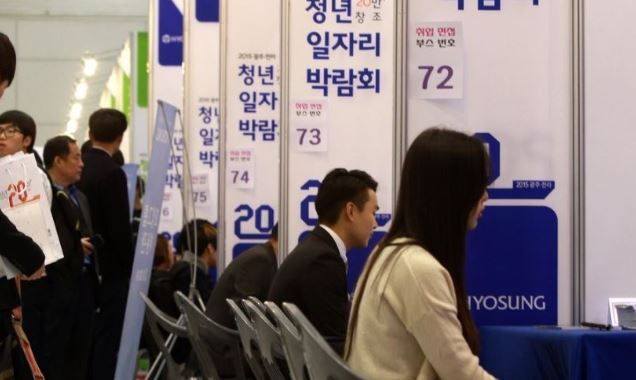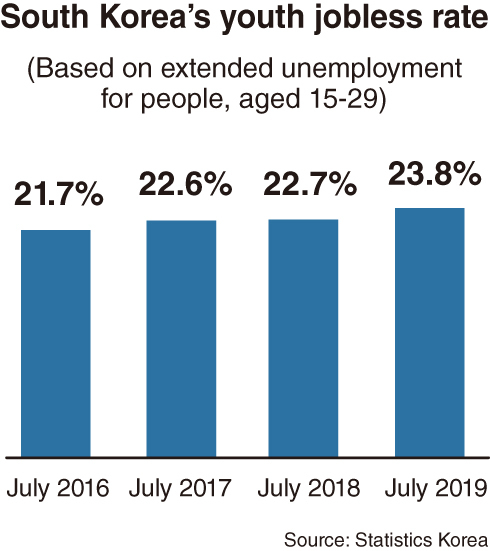[News Focus] Young jobless Koreans de facto exceed 1 million
By Kim Yon-sePublished : Aug. 26, 2019 - 17:03
SEJONG -- South Korea’s unemployment rate for people aged between 15 and 29 posted 9.8 percent in July, a government release showed.
This might indicate that 9 out of every 10 young Koreans are employed. The estimation, however, is based on wide inclusion of those engaged in nonregular or temporary jobs as being hired, which cannot exactly reflect the tight job market situation in the nation.
Youth employment in the nation turns critical when it refers to the Supplementary Index III for Employment, provided by Statistics Korea. Its data showed that the “extended (or sentiment-reflected) jobless” rate for young people marked 23.8 percent as of last month.
This means that nearly 1 in 4 young Koreans have been out of work.
People deemed to be among the “extended jobless” involve temporary employees who work fewer than 36 hours a week and want to change jobs, as well as seasonal workers who are out of work for part of the year.
Since four years ago, Statistics Korea has compiled the extended unemployment rates in a document titled the Supplementary Index III for Employment, as an effort to shed a clearer light on unemployment and underemployment trends.
This might indicate that 9 out of every 10 young Koreans are employed. The estimation, however, is based on wide inclusion of those engaged in nonregular or temporary jobs as being hired, which cannot exactly reflect the tight job market situation in the nation.
Youth employment in the nation turns critical when it refers to the Supplementary Index III for Employment, provided by Statistics Korea. Its data showed that the “extended (or sentiment-reflected) jobless” rate for young people marked 23.8 percent as of last month.
This means that nearly 1 in 4 young Koreans have been out of work.
People deemed to be among the “extended jobless” involve temporary employees who work fewer than 36 hours a week and want to change jobs, as well as seasonal workers who are out of work for part of the year.
Since four years ago, Statistics Korea has compiled the extended unemployment rates in a document titled the Supplementary Index III for Employment, as an effort to shed a clearer light on unemployment and underemployment trends.

Under the state’s customary statistics, which specified the July youth jobless rate at 9.8 percent, the number of unemployed stayed at only 435,000 out of the economically active population, aged 15-29, totaling 4.43 million.
But the 23.8 percent in extended youth jobless rate suggests that the number of unemployed young people ranges between 1.05 million (based on out of the economically active population, aged 15-29, 4.43 million) and 1.21 million (out of the extended economically active population for the same age group, 5.1 million). The agency has yet to publicize the monthly figures for the number of extended unemployed.
“This indicates that at least 1 million Koreans in their 20s and late teens are de facto in the status of jobless,” said a demographic researcher in Seoul.
The extended youth unemployment rate has climbed 0.9 percentage point, compared to 22.9 percent in May 2017, when President Moon Jae-in took office. It also marked an increase by 2.1 percentage points from three years earlier in July 2016, when it stayed at 21.7 percent.
The figure was 21.3 percent in November 2016, when the influence-peddling scandal involving former President Park Geun-hye and confidante Choi Soon-sil hit the nation. But since then, it reached an all-time high of 25.2 percent in about 2 1/2 years in April 2019.

Though the government highlighted that the number of employed in their 20s has recently increased, some experts remain skeptical about the quality of the jobs created.
A professor from the Labor Research Institute of Korea University was quoted by a news outlet as saying that “the improvement in youth hiring could be attributed to an increase in part-time or short-term jobs rather than an improvement in stable jobs.”
He pointed out that it is urgent for the government to push for the creation of fundamentally stable jobs, citing the extended jobless rate.
President Moon Jae-in -- just after he was elected in May 2017 -- showcased an electronic dashboard to the media, which was set up in the presidential office for the purpose of monitoring the number of jobs created.
A large portion of people here, including the youth, were pinning high hopes on the new administration. But they have not seen the president pose beside the dashboard at any time in the 27 months since.
And 2018 was one of the few periods in which young Koreans had greater difficulty than before in getting jobs and many young small business owners went under because of worsening economic factors.
A huge number of college students are saddled with debt from tuition loans combined with low opportunity for regular employment, which has seen the lowest approval rate of below 30 percent for President Moon among men in their 20s.
According to a poll from the Seoul Institute, about a third of households, or 33.1 percent of the surveyed 1,000 residing in Seoul, responded that the high unemployment rates for the youth is the most significant issue this year.
By Kim Yon-se (kys@heraldcorp.com)






![[From the Scene] Monks, Buddhists hail return of remains of Buddhas](http://res.heraldm.com/phpwas/restmb_idxmake.php?idx=644&simg=/content/image/2024/04/19/20240419050617_0.jpg&u=20240419175937)





![[Graphic News] French bulldog most popular breed in US, Maltese most popular in Korea](http://res.heraldm.com/phpwas/restmb_idxmake.php?idx=644&simg=/content/image/2024/04/18/20240418050864_0.gif&u=)


![[From the Scene] Monks, Buddhists hail return of remains of Buddhas](http://res.heraldm.com/phpwas/restmb_idxmake.php?idx=652&simg=/content/image/2024/04/19/20240419050617_0.jpg&u=20240419175937)

![[KH Explains] Hyundai's full hybrid edge to pay off amid slow transition to pure EVs](http://res.heraldm.com/phpwas/restmb_idxmake.php?idx=652&simg=/content/image/2024/04/18/20240418050645_0.jpg&u=20240419100350)

![[Today’s K-pop] Illit drops debut single remix](http://res.heraldm.com/phpwas/restmb_idxmake.php?idx=642&simg=/content/image/2024/04/19/20240419050612_0.jpg&u=)